
The seasonal bruschetta pizza at Psychic Pie adds first-of-the-season local tomatoes atop an award-winning sourdough crust.
The post Psychic Pie Is Having a Tomato Moment With a Summer-Only Pizza appeared first on Sonoma Magazine.
]]>
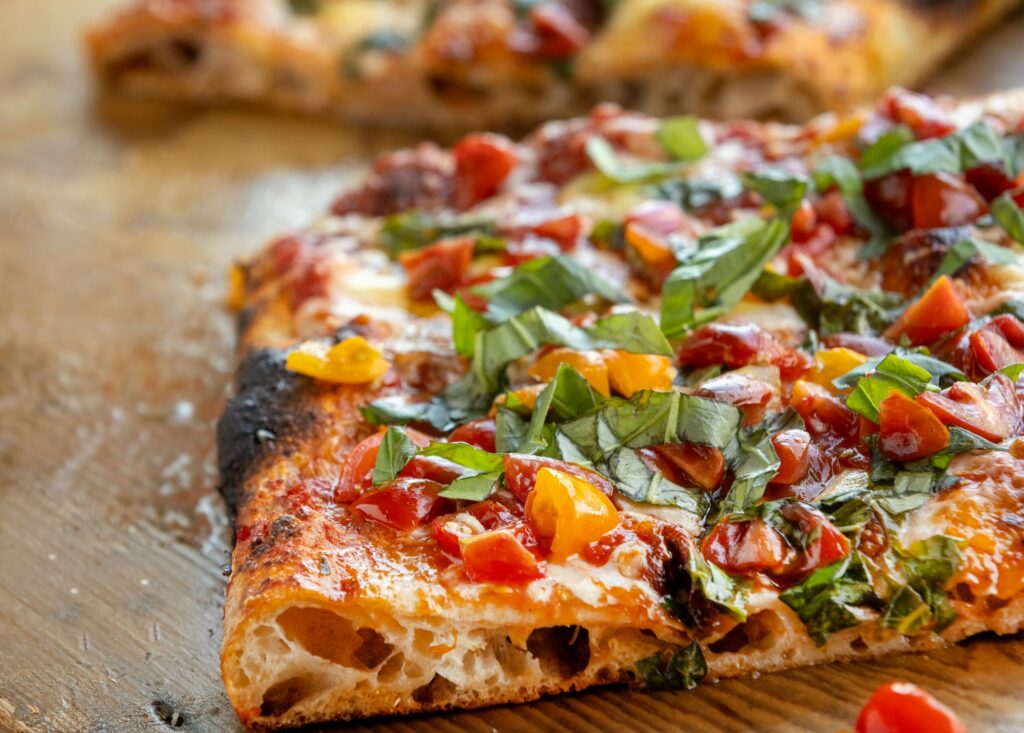
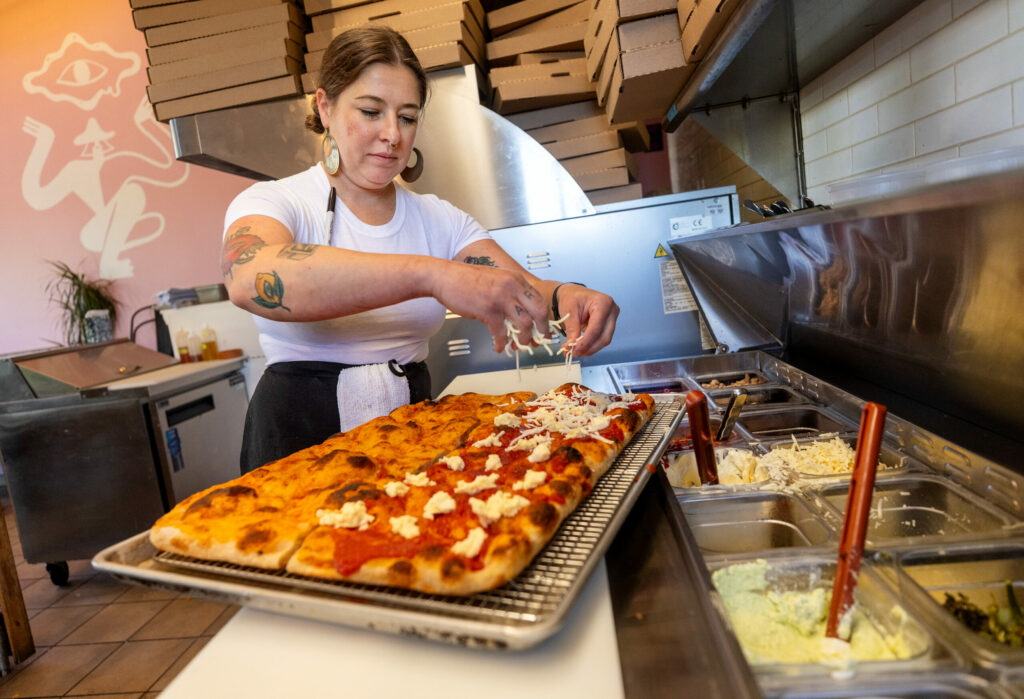
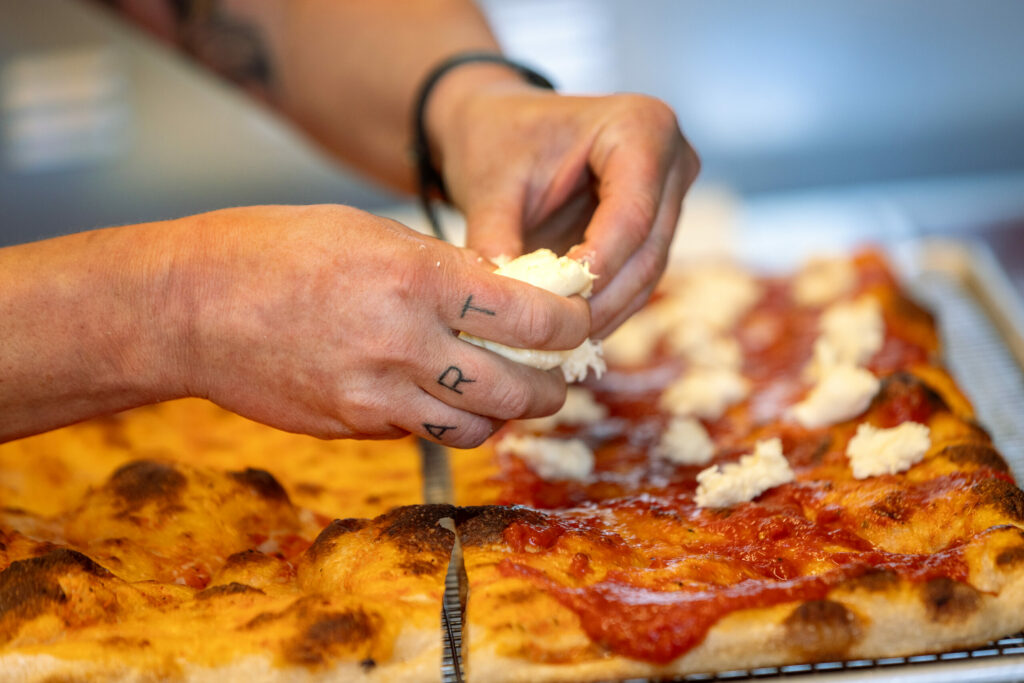
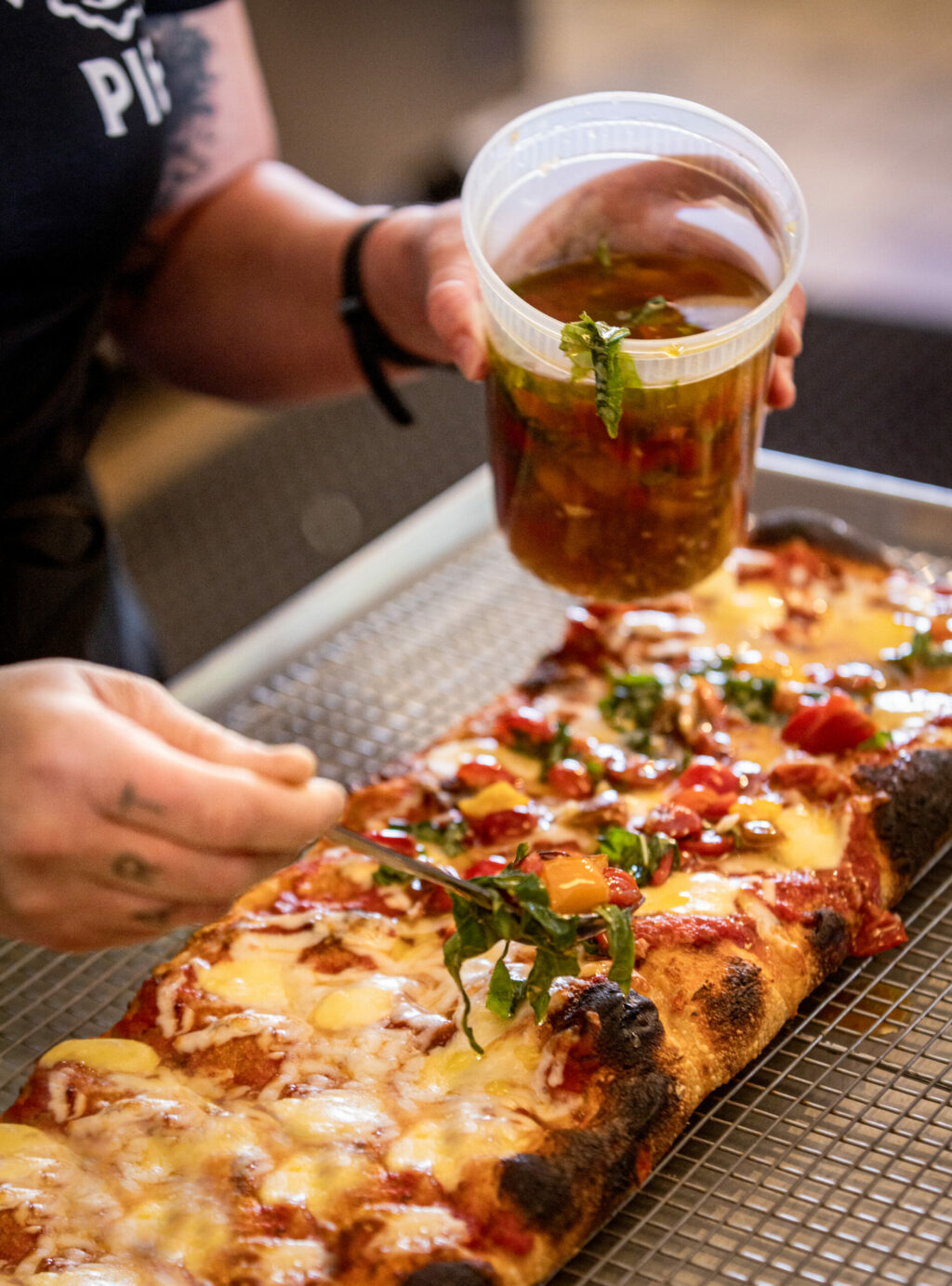
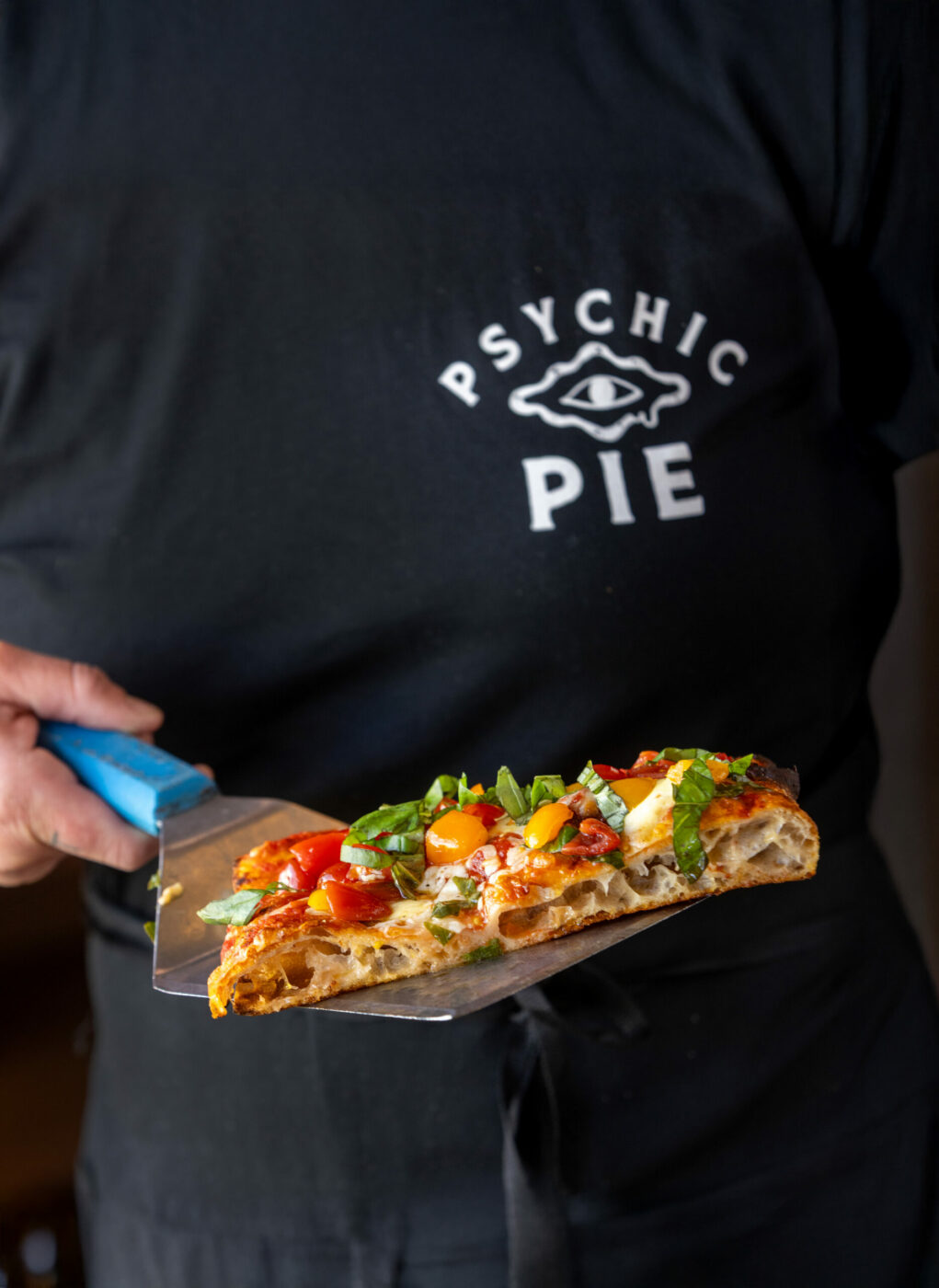
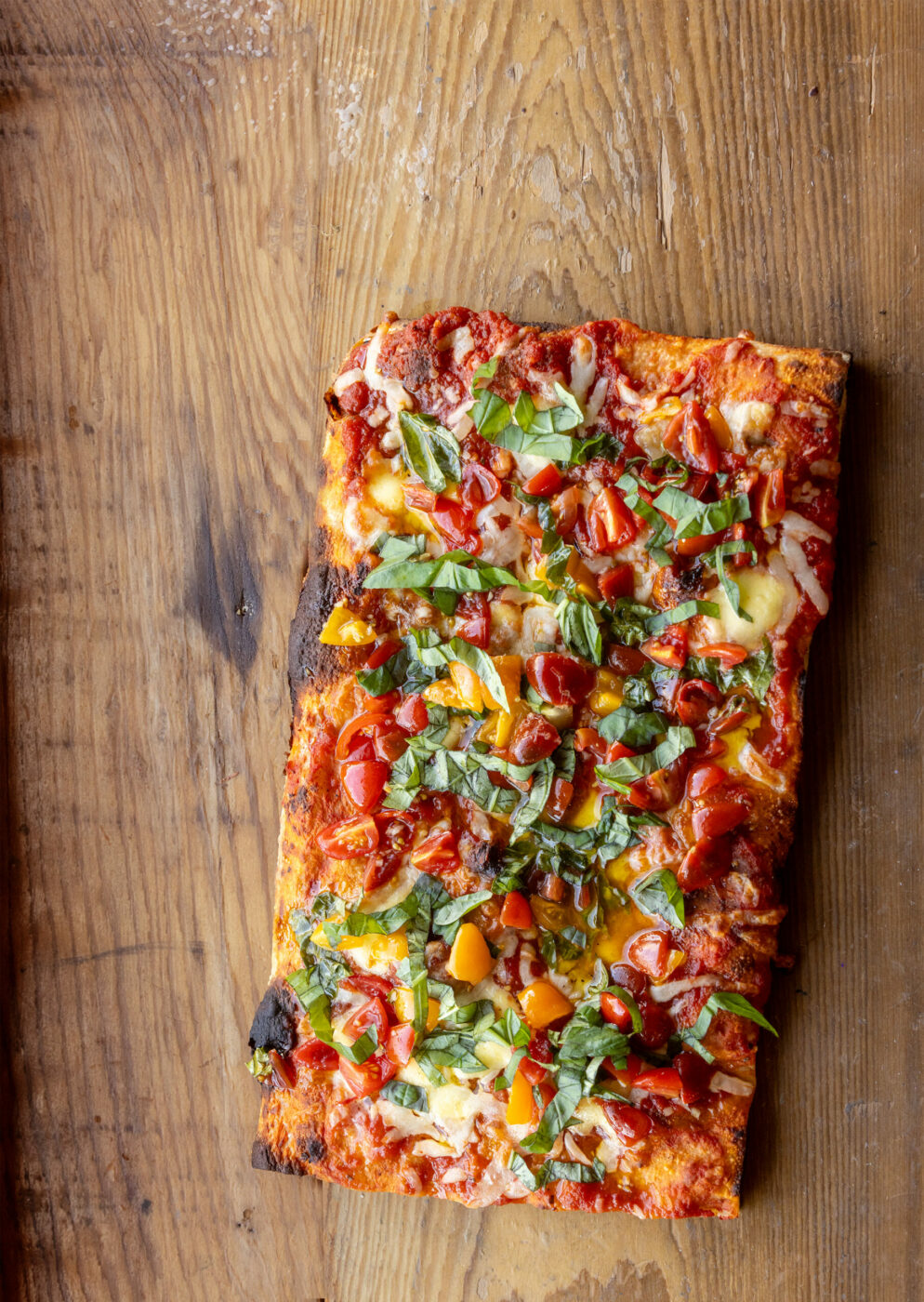
Sure, tomatoes are available year-round, but is there anything more delicious than red, ripe cherry tomatoes or super-sweet Sungolds right off the vine?
The summer-only bruschetta pizza at Psychic Pie pairs first-of-the-season local tomatoes with their herbal bestie, basil, atop an award-winning Roman-style sourdough pizza crust.
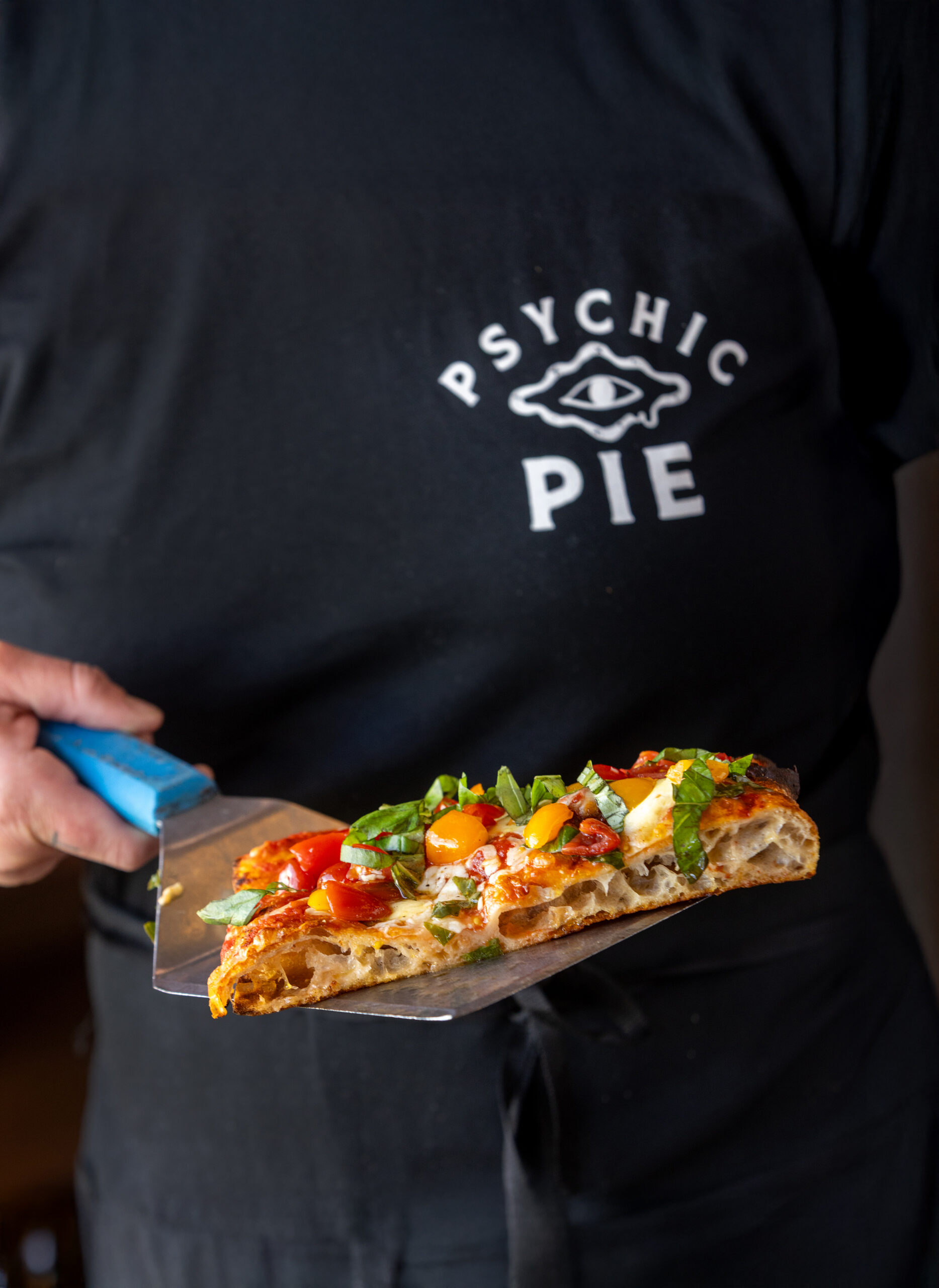
“Sungolds have become super-popular. That’s my favorite variety I always try to mix in there,” says Leith Leiser-Miller, Psychic Pie’s co-owner along with her husband, Nicholi Ludlow. “The bruschetta pizza makes me think of something simple that’s refreshing and filling and delicious that I can eat outside.”
A glistening drizzle of golden balsamic vinegar and a sprinkle of aged Estero Gold Reserve cheese connect the dots on this tasty seasonal slice.
980 Gravenstein Highway S., Sebastopol. 707-827-6032, psychicpie.com
Want to get your own summer tomatoes? Find them at one of our favorite local farmstands. Find more of the best pizza spots in Sonoma County here.
The post Psychic Pie Is Having a Tomato Moment With a Summer-Only Pizza appeared first on Sonoma Magazine.
]]>
The grape crush isn’t the only harvest happening in September and October in Sonoma County.
The post More Than Grapes: The Best of Sonoma County Harvest appeared first on Sonoma Magazine.
]]>






The grape crush isn’t the only harvest happening September through October in Sonoma County. Not by a long shot. Though the scent of fermenting grapes is our Sonoma aroma during these final warm months, here are a few more things being picked in Wine Country.
Tomatoes
From Berkeley Tie Dye and Early Girl to Paul Robeson, Indigo Jewel, Cool Chocolate Pear and literally thousands of other specialized heirloom breeds, it’s that time of year when gardens and markets are overflowing with summer’s favorite fruit (or vegetable, depending on how botanically precise you want to be).
Soda Rock Farms is synonymous with summer tomatoes in Sonoma County, and the Healdsburg family farm often yields up to 1,000 pounds of heirloom tomatoes each day during their peak time, which is late August through September. Look for Soda Rock, along with dozens of other locally grown tomatoes, at farmers markets throughout the county.
Want to pick your own? The Black Piglet at Davis Family Vineyards in Healdsburg encourages diners to hunt out their favorite tomato at the farm for a fresh u-pick BLT that will be the best thing you eat all fall. Open through October.
Apples
From mid-August through September, the apple orchards of Sonoma west county are in full swing. Though the coveted Gravensteins are often picked clean by late August, dozens of other varietals grown throughout the county last well into fall.
A few farms allow CSA members, groups and occasional passers-by to come pick, including Chileno Valley Ranch, Gabriel Farm and Apple-A-Day Ratzlaff Ranch. It’s also high-season for cider apples, usually tart heirloom apples used for the county’s flourishing hard cider industry. Ask around, and you’ll probably find a friend more than happy to help you harvest their apples.
Pumpkins
There’s no shortage of pumpkin patches and corn mazes around Sonoma County. The Petaluma Pumpkin Patch and Amazing Corn Maze, just north of Petaluma and visible from Highway 101, allows locals to watch the corn rise and pumpkins grow throughout the summer. Though it’s also a source of some consternation (and serious slowdowns) throughout the season as lookie-loos drive by, there’s no doubt it’s still a favorite destination. Open to visitors from late September.
Cannabis
With recreational marijuana legalized, and coming into the marketplace early next year, outdoor cannabis farmers have been busily growing the county’s biggest cash crop. While marijuana grown indoors or with light-deprivation techniques to foster quicker flowering can be harvested multiple times each year, sun-grown marijuana has a relatively short window of harvesting — beginning in late October through November. Cannabis then goes through a drying and trimming process before being sold. The Emerald Cup, held at the Sonoma County Fairgrounds in early December, is a competitive celebration of the year’s harvest.
The post More Than Grapes: The Best of Sonoma County Harvest appeared first on Sonoma Magazine.
]]>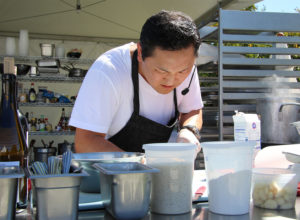
Chef competition features heirloom tomatoes, major chefs and lots of fun at the 20th Annual Heirloom Tomato Festival at Kendall Jackson Winery in Santa Rosa.
The post Food Porn: Kendall Jackson’s 20th Annual Heirloom Tomato Festival appeared first on Sonoma Magazine.
]]>






The 20th Annual Kendall-Jackson Heirloom Tomato Festival features hundreds of heirloom tomatoes, local restaurants featuring their own tomato recipes and bites, along with a Top Chef style competition pitting nationally recognized chefs preparing everything from anchovies and Snake River Farms pork to locally sourced salmon and even a bit of liquid nitrogen frozen horseradish from Chef Sang Yoon and Douglas Keane.
The post Food Porn: Kendall Jackson’s 20th Annual Heirloom Tomato Festival appeared first on Sonoma Magazine.
]]>The post A Nicoise Salad in Winter, and The Rules appeared first on Sonoma Magazine.
]]>






One could write at least a novella on le salade Nicoise – indeed, foodies collectively have written several – and still fail to define what must, and what must never, find its way to the plate (some excellent arguments about what might be definitive, as well as summary reviews of the more authoritative recipes, may be found here and here). Or one could do as I have done, and thumb through some of the reference points for classic French (and specifically Provencal) cooking, say Gastronomique (Larousse) , The Cuisine of the Sun (M. Johnston), and Mastering the Art of French Cooking (J. Child). One might also, and rightly, compare the lot of it to the recipes of Auguste Escoffier – the “king of chefs, and the chef of kings” – who happened to born in (or nearly in) Nice, and who provides his take as version as No. 2015 in Le Guide Culinaire. Regardless, upon distilling the mash, you’ll inevitably find at least as much contradiction as you will coherence, even about the most seemingly fundamental aspects:
- You must never use lettuce. Or, you must always use lettuce, but only Gem, Bibb, or a similarly tender and unobtrusive leaf. (I’ve only ever been served the with-lettuce version, although I see no reason why you couldn’t make it more like a chopped vegetable salad and skip the leaves – particularly if you use a broad array of raw vegetables.)
- You must only use raw vegetables, including tomatoes as the centerpiece, as well as baby artichokes, lima beans, bell peppers, cucumber, fennel and radishes. Except, of course, for the black olives. And maybe the capers, if you’re using them, but generally you shouldn’t. (I’ve never been served a version with artichokes, beans, cucumber, fennel, and radish, although I’ve probably had each individually or in some combination. The central role of tomatoes, however, seems one of the few irreducible constants.)
- Either you must never use blanched haricots verts or boiled potatoes – or, they are essential. (I am sure that the raw-vegetable version is outstanding, but I love the extra heft given the dish by the starch from potatoes and beans, particularly if you’re serving the salad as a main course for dinner, as I was last night, and particularly in winter.)
- You must include either tuna or anchovies, but never both. If you do use tuna, you must only use canned, oil-packed, Mediterranean tuna, never water-packed, and certainly never fresh. (Apparently, it was Escoffier who “added” tuna in the first place, and it has been broadly considered to be mandatory ever since. I greatly prefer it this way, with both, although anchovies alone – if of sufficiently high quality and in adequate quantity to flavor the whole of the dish – would certainly be fine. I love seared tuna, but please don’t put it on a salad and call it Nicoise.)
- Hard-boiled eggs (oeufs dur to the French – cooked through, but just, with yolks that do not cake and crumble) are mandatory. Or maybe they’re verboten – none other than Monsieur Escoffier himself left them out. (I’ve never been served a Nicoise without eggs, and nor do I want to – I’m sure it’s fine without, just as I’m sure it’s better with.)
- The only acceptable dressing is a simple vinaigrette of oil, vinegar, salt, pepper, mustard and – depending whom you ask – fresh garlic and fines herbs. (I adamantly agree on the dressing – keep it simple, and don’t screw it up. I actually didn’t use garlic last night, but knowing what I do of the cuisine of the Sud-Ouest and the dish itself, next time I will.)
- You should definitely add finely sliced red or green onions. Or, really, you shouldn’t. (I don’t have a strong opinion on this one, as I like the slightly bitter heat and purple color they add to the salad, but generally find raw onions overpowering. I have not, generally, been served raw onions on my salad, but I won’t object, so long as there are not too many, and they are very finely sliced.)
- The salad is never to be tossed; prep the components individually, and compose the salad in layers, right before service. (This is absolutely correct, as any attempt at tossing will only serve to break apart the eggs and cause all the otherwise distinct components to mash together, destroying the essential sensation of all those discretely defined elements acting both independently assertive and perfectly harmonious.)
So, sitting here just after the equinox, on the heels of a preposterously late growing season – late enough for sweet bell peppers in winter, although certainly not tomatoes – what did I do? I raided the closest farm stand and our local healthy-foods store – yielding, jointly, organic sweet red peppers, baby new potatoes, green beans, red onion, and a Bibb-like head of lettuce; a basket of truly free-range eggs; and imported Italian sardines and tuna, packed in olive oil – and followed Ms Child’s recipe, more or less to a “T”, minus the tomatoes. I’m quite certain that, regardless of whatever else I did rightly or wrongly, the absence of tomatoes precludes me from calling this a true Salade Nicoise. But I’m equally certain that it was better than the vast majority of the version I’ve been served, and that it was a far sight better than waiting until next July or August for a nice tomato.
Classic Salade Nicoise (Adapted from J Child)
- Make a few cups’ worth of cold French-style potato salad (boil the potatoes, peel and slice them when just done, and dress with white wine and a simple vinaigrette of olive oil, wine vinegar, mustard, lemon juice, and parsley). Be sure not to overcook the potatoes or they’ll fall apart on the plate.
- Blanch a few cups of green beans in salted water. Err on the side of al dente.
- Gently cook through 2-4 eggs (for a room temperature egg, put them in cold water, bring rapidly to a boil, then turn off the heat, cover for 10 minutes, and cool rapidly in ice water – this will result in a fully cooked egg with a dark yellow and n0t-chalky yolk). Allow eggs, potatoes and beans to cool (this may all be done ahead, but don’t dress the beans).
- Julienne a sweet red pepper and a few anchovy fillets.
- Just before serving, prepare a cup of classic French vinaigrette with garlic and freshly chopped green herbs – parsley, basil, chives, tarragon – although, personally, I am not at all crazy about Tarragon in this dish. Dress the tomatoes and beans, allowing the tomatoes to “bleed out” some of their liquids. (Simply ignore the tomatoes if you’re doing this in winter, but consider an extra pepper for color and be sure the whole of the dish has adequate acidity.)
- Separate and then dress the salad leaves and arrange in a large bowl (or on individual plates – but it makes a really nice “family-style” dish as well).
- Arrange a bed of potatoes, green beans, and tomatoes on top of, and encompassed by, the bed of lettuce leaves.
- Intersperse with a random pattern of tuna chunk (be sure to get an Italian tuna, packed in olive oil; for an incomparable treat, get a can of “tuna belly” – essentially, sushi-grade toro that has been canned in olive oil and salt – very expensive, but insanely good), quartered egg (as always, very fresh and free-range), and black olive (preferably an oil-cured black olive from Provence), and drape the julienne strips of pepper and anchovy over the top.
- Alternatively, compose the salad – either on top of a bed of dressed leaves, or without lettuce entirely – in sections on the plate, a quadrant of tuna, a little pile of beans, one of tomatoes, etc.
- Serve with a good crusty sweet baguette and a chilled rose.
- If you can get everything but tomatoes – please, please do not use out of season tomatoes for this dish – then make it like I did in the picture. It may not transport you to Nice, but it’s definitely the next best thing.
The post A Nicoise Salad in Winter, and The Rules appeared first on Sonoma Magazine.
]]> I've been thinking about cooking green. And no, I'm not pandering to my more aggressively environmentalist brethren, I'm talking about the color green, the shades of which the human eye is more sensitive to than any other part of the visible spectrum: The haughty, peacock green of my grandmother's emerald broach; the brooding, mossy green of the Russian River pooling under Wohler Bridge...
I've been thinking about cooking green. And no, I'm not pandering to my more aggressively environmentalist brethren, I'm talking about the color green, the shades of which the human eye is more sensitive to than any other part of the visible spectrum: The haughty, peacock green of my grandmother's emerald broach; the brooding, mossy green of the Russian River pooling under Wohler Bridge...
The post The Accidental Vegetarian: Cooking Green appeared first on Sonoma Magazine.
]]>






I’ve been thinking about cooking green. And no, I’m not pandering to my more aggressively environmentalist brethren, I’m talking about the color green, the shades of which the human eye is more sensitive to than any other part of the visible spectrum: The haughty, peacock green of my grandmother’s emerald broach; the brooding, mossy green of the Russian River pooling under Wohler Bridge; the wicked, tempting greens of jalapeno peppers and the Witch of the West, the quiet greens of my wife’s eyes or pine boughs in snowy relief, and the cool greens of Key lime pie and margaritas by the pool. Green. It’s the new black, or whatever.
And yet, despite the remarkable human capacity to perceive green in all its rich and verdant glory, it’s hard for me to think of either a more nondescript or vaguely depressing menu billing as the ubiquitous “green salad”. Every time I read that line, I am transported, as if by some strip-mall perversion of Monsieur Proust’s cookie, to the nearest Sizzler-Olive Garden-Applebee’s-Chili’s, or my college cafeteria, with its dubious cornucopia of flaccid, tired “greens”, really more beige than green, the browning leaves marked, perhaps, by a disturbing pinkish edge, were I to look closely enough…
This all comes to mind because my wife, who vastly prefers to think about animals as pets rather than ingredients, and who happens to count green as her very favorite color, occasionally likes our otherwise steady diet of carbs and protein interspersed with fresh vegetables, and so I decided to make a green salad that would actually be green, entirely of its own natural accord: Brilliant, emerald-green arugula from Bernier Farms; chartreuse Green Zebra heirloom tomatoes from Soda Rock; and a simple vinaigrette, studded with mossy-green peppercorns.
(As an aside, master the home-made vinaigrette – what Thomas Keller called “a perfect sauce” – and you’ll never buy salad dressing again. The basic technique is a simple emulsion – check out the Foodista widget below for a quick tutorial – from which, with the right proportions of acid, fat, and seasoning, and a whisk, all dressings are possible.)
 Emulsify
Emulsify
The post The Accidental Vegetarian: Cooking Green appeared first on Sonoma Magazine.
]]> The Costco Report: A recurring, if episodic, column devoted to ferreting out the more promising offerings, as well as to warding off the worst of the hazards. This Week's Pick: Organic Extra Virgin Olive Oil, at about $7/liter.
The Costco Report: A recurring, if episodic, column devoted to ferreting out the more promising offerings, as well as to warding off the worst of the hazards. This Week's Pick: Organic Extra Virgin Olive Oil, at about $7/liter.
The post The Costco Report appeared first on Sonoma Magazine.
]]>






The Costco Report: A recurring, if episodic, column devoted to ferreting out the more promising offerings, as well as to warding off the worst of the hazards.
This Week’s Pick: Organic Extra Virgin Olive Oil (about $21 for two 2-liter bottles)
Alas, our fair county’s Autumn weather – more than a few scattered showers and increasingly chilly evenings – hasn’t been conducive to margaritas, so I’m still sitting on a healthy stockpile of the agave nectar I secured during my previous tactical assault on the Big C. On the other hand, as despondent as I may be over the faltering flow of tequila into my limeade, I do love the change of seasons and the cooking that comes with it, so that’s what I tried to keep in mind as I struggled to maneuver my Titanic shopping cart across an arctic sea of dubious pre-fab meals and food-sample ice floes. Autumn cooking, at least in my kitchen, means several things – lots of slow braises, smoke detector-hot pizza stones, and richly sauced pastas – but above all it means soups. And soups, at least in my kitchen, always get a garnish.

One of the very easiest ways to add a splash of color and spice to everything from salad to soup is with a flavored oil. Flavored oils – typically a handful of something colorful and tasty and a pinch of salt, blended with oil and then strained – are trivially easy to make, store well, and make your plates look cool. Granted, you run some risk that either Bobby Flay cites you for copyright infringement or the 80s ask for their plates back, but as a rule, flavored oils are a pretty good crutch for the home cook. And they’re almost impossible to screw up.
Flavored Oil
The possibilities really are limitless, but I generally try to use flavors that go with a wide variety of dishes, that have good color, and that I’ve already got to hand, including staple herbs, such as parsley, basil, and chives, and almost any brightly colored and sharply flavored chili peppers. Simply start with a quarter cup or so of good quality olive oil; add a handful of whichever flavoring ingredient you’re keen on; and blend or run through a food processor until smooth. I will usually, but by no means always, pass the oil through a fine-mesh strainer in order to remove the big particulates.

In terms of the base oil itself, and the subject of this Report, the olive oil in question – labeled “Organic Extra Virgin” under the “Kirkland Signature” house brand – is seriously good stuff. It’s not just cheaper (by a wide margin) than the similar product at Safeway, TJ’s, or – heaven forbid – Whole Paycheck, it’s considerably better: Bright, grassy, slightly peppery, with a nice, round mouth feel, pretty much everything you’d want in an every-day olive oil. If you really want to think about the oil you buy, check out the good review here, as well as the UC Davis study, in which the vast majority of imported olive oils fail to pass accepted quality standards (oils produced in California fared considerably better – chalk one more up for local food sourcing).
The post The Costco Report appeared first on Sonoma Magazine.
]]>